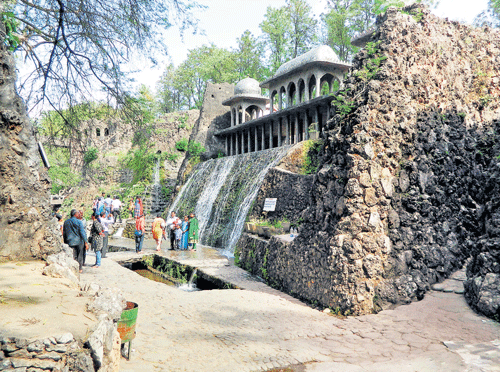
The 25 mosaic-tile-textured birds sit on the compound wall made of used tar drums, looking down indulgently upon the visitors entering the Rock Garden.
We entered unsuspectingly with bowed heads through the low doorway, and for the next couple of hours were lost in the maze of pathways experiencing with delight a magical kingdom and its inhabitants. This is Chandigarh’s world-famous Rock Garden, a ‘Devtaon Ki Nagri’ (kingdom of gods), as its unassuming creator, Nek Chand Saini fondly calls it.
Set amidst lush green trees and waterfalls, this 40-acre Rock Garden is located in Sector 1 of North Chandigarh, attracting nearly 5,000 visitors everyday.
Chandigarh is popular as a planned city, but this garden with its deceptively unplanned confusion of rocks, mazes, waterfalls, plazas and pavilions, is peopled by creatures and beings from out of this world — made exclusively from discarded waste material.
Low doorways are an intentional aspect of this garden, to force the visitors to show humility to the gods and goddesses of this kingdom.
Work in phases
The first phase of the garden is the artist’s ‘Ode to Nature’. Nek Chand has painstakingly collected and put up a display of a unique collection of drift stones on either sides of the twisting pathways. He had collected these from river beds, mountains and jungles.
We marvelled at the stones that appeared different to each beholder. I guess nature lets you see with your ‘inner eye’.
We paused near the small mud hut where Nek Chand first began working on creating this kingdom of gods. For a first time uninformed visitor, it is a constant source of pleasure to be surprised at every turn.
You walk narrow passages and emerge into wide open clearings; you climb steps and walk down to streams and bridges; into brilliant sunshine and then into cool shade.
Overhead, the tall trees of the jungle and the birds seem to eye the visitors warily, lest the land nestled in their midst be harmed. Huge waterfalls, smaller waterfalls and streams owe their existence to the ingenuity of Nek Chand. He cleverly designed them to work all through the year, employing rain water harvesting and recycling.
The second phase has sculpted human and animal figures — gods and goddesses of this imaginary kingdom. Soldiers, village belles carrying pots, school children, dancers — all from Nek Chand’s memories of his native village.
We were propelled through a dynamically changing world fashioned out of discarded tube lights, rusting tar drums, broken tiles, ceramic switches, cups, saucers and other chinaware, sanitary ware, unused building material, street lights, burnt bricks, small earthen pots, broken glass bangles, wires, cement sacks and even hair from barber shops.
Most visitors are drawn to the arresting assembly of people clothed in broken glass bangles. This is immortalised in the commemorative postage stamp issued in 1983 by the Indian Postal Department.
Shimmering in the morning sunshine are colourful birds with plumage made from broken bangles. Sad faced monkeys, tigers, elephants all stand rooted in their places as if interrupted at some magical moment. School children in drill positions, soldiers ready for war and village folk at their chores all stunned to silence and frozen in time.
Remarkable creation
The third phase is an ‘Ode to Celebration’. Life-sized horses ready to gallop wait on huge arches, shining in all their white tiled glory. Many family size swings wait to let one slip seamlessly back into childhood.
There is a huge amphitheatre, an aquarium, exhibition gallery and a row of big ‘laughing mirrors’. We watched American and British volunteers for the Nek Chand Foundation patiently gluing pieces of colourful mosaic tiles on the pillars.
It is remarkable how a simple road inspector with no formal training in design or architecture could fashion a kingdom from discarded waste. Nek Chand was born in 1924 in Berian-Kalan, now in Pakistan, and moved to India with his family during the Partition in 1947.
In 1951, he was employed as a road inspector with the Public Works Department in Chandigarh. In his spare time, Chand began cycling to river beds, mountains and jungles collecting materials that looked interesting to him.
He also collected scrap from demolition sites around the city. He worked with his own vision of the divine kingdom, choosing a gorge in a forest near Sukhna Lake for his work. So, clearing a little space in the jungle, he began indulging in his dream. But Nek Chand was able to hide it from prying eyes for 18 years, before it was discovered by the authorities.
It had grown into a 12-acre complex of interlinked courtyards, each filled with hundreds of pottery-covered concrete sculptures of dancers, musicians and animals. He was like a child playing with his toys and never dreamed of fame or publicity.
Emerging outside the garden to the city’s planned beauty and orderliness with bowed heads, we were still under the spell of the world behind the tar drums.
If a mischievous God breathed life into them that moment, I could imagine the clamour of voices from inside the garden deploring the ’real’ people who waste, burn and destroy mindlessly, unlike the artist who transformed waste to create them.
As the famous quote of John C Sawhill of the world’s largest private conservation group, The Nature Conservancy, goes, “A society is defined not only by what it creates, but by what it refuses to destroy”.